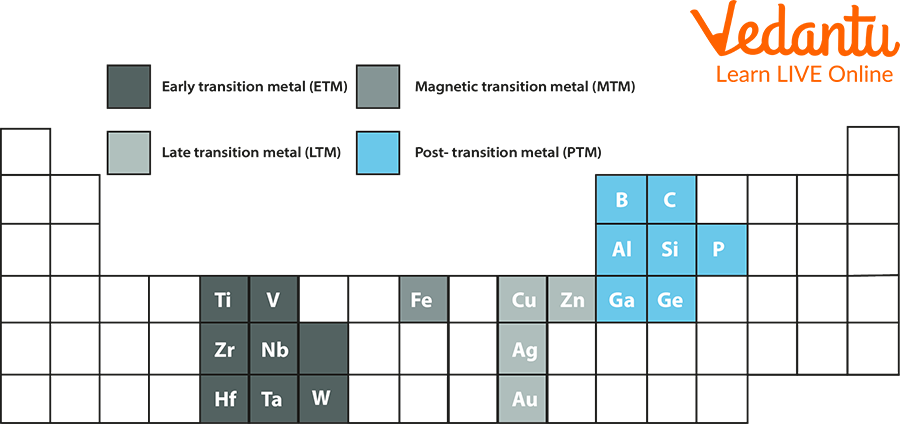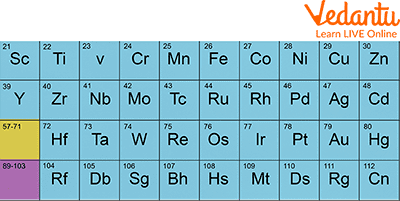




Introduction to Post Transition Metals
A group of elements in the periodic table are known as the post-transition metals. They are situated to the left of the metalloids and the right of the transition metals. In addition, they are referred to as "other" and "poor" metals. The name for this class of metals (poor, other, post-transition) and which elements should be included are up for debate among scientists.
Typically, any metal from groups 13, 14, and 15—aluminium, gallium, indium, tin, thallium, lead, and bismuth—constitutes post-transition metals. Additionally, polonium is frequently categorised as a post-transition metal. The representation of post-transition metals is shown below.

Post-transition Metals
Similar Properties of Post Transition Metal
Post-transition metals have a lot of similar qualities, like:
Under normal circumstances, they appear as solid metal.
They are ductile, malleable, and effective heat and electrical conductors, like most metals.
They're fairly densely packed together.
They typically are softer and have lower melting and boiling temperatures than transition metals.
Periodic Trends of Post Transition Metals
Since there are typically fewer electrons available for metallic bonding when atomic radii decrease and ionisation energy increase, ions are typically smaller, more polarising, and more likely to form covalent connections. As a result, they exhibit less metallic nature.
Order of Abundance
Aluminium, which is also the most common metal in the Earth's crust, is the most common of the post-transition metals on Earth. The abundance of post-transition metals in the Earth's crust is listed below in order:
Aluminium
Gallium
Lead
Tin
Thallium
Indium
Bismuth
Uses of Post-Transition Metals
There are numerous uses of the various elements of this family. For creating kitchenware, electronics, soldering, and plating steel, aluminium and tin are employed. Pepto-Bismol, a medication used to settle upset stomachs, is made from bismuth. Gallium is utilised in semiconductors and fuel cells, while Indium is used in electronics, such as touch screens and flat panel displays. Among other things, lead is utilised in the production of batteries.

Transition Elements List
Interesting Facts About Post-Transition Metals
Now, let’s read some interesting facts about post-transition metals
Sometimes post-transition metals are used to group zinc, cadmium, and mercury instead of transition metals.
After silicon and oxygen, aluminium is the third most common element in the crust of the Earth.
In some cases, metalloids rather than post-transition metals are used to describe germanium and antimony.
The melting point of gallium is just slightly over room temperature, and it will melt in your hand.
Pepto-Bismol, a medication used to soothe upset stomachs, contains bismuth.
Formerly believed to be the heaviest stable element, bismuth has lately been shown to have a small amount of radioactivity.
Electronics such as touch screens and flat panel displays employ indium.
The Greek word "thallos," which means "a green sprout or twig," is where the name "thallium" originates.
Thallium is extremely poisonous and lethal. Hair loss is one sign of thallium toxicity.
Summary
In this article we have discussed similar example of transition metal, transition elements list, order of abundance, uses and interesting facts about post transition metal. The set of metals on the periodic table is referred to as post-transition metals or poor metals. The transition metals are to their right of them. We also learned what is meant by transition elements. We learned that when compared to transition metals, post-transition metals often have higher electronegativities.
Furthermore, their melting points are lower. In general, they are softer than other metals. Lead, tin, and other soft metals are among them.
FAQs on Post Transition Metals
1. Is Zn a post-transition metal?
No, transition metals are those metals with partially filled d-orbitals. Zinc is not a metal for transition because it has entirely occupied the d-orbital.
2. Are post-transition metals reactive?
The metals of Groups IIIA, IVA, and VA are categorised as post-transition metals. They consist of bismuth, lead, tin, gallium, indium, thallium, gallium, and aluminium. Only aluminium is regarded as being an extremely reactive post-transition metal.
3. Where are post-transition metals found?
The post-transition metals are situated to the left of the metalloids and to the right of the transition metals. In addition, they are referred to as "other" and "bad" metals.









